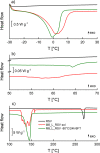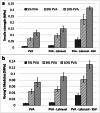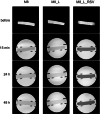Poly(Vinyl Alcohol) Cryogel Membranes Loaded with Resveratrol as Potential Active Wound Dressings
- PMID: 33718994
- PMCID: PMC7956935
- DOI: 10.1208/s12249-021-01976-1
Poly(Vinyl Alcohol) Cryogel Membranes Loaded with Resveratrol as Potential Active Wound Dressings
Abstract
Hydrogel wound dressings are highly effective in the therapy of wounds. Yet, most of them do not contain any active ingredient that could accelerate healing. The aim of this study was to prepare hydrophilic active dressings loaded with an anti-inflammatory compound - trans-resveratrol (RSV) of hydrophobic properties. A special attention was paid to select such a technological strategy that could both reduce the risk of irritation at the application site and ensure the homogeneity of the final hydrogel. RSV dissolved in Labrasol was combined with an aqueous sol of poly(vinyl) alcohol (PVA), containing propylene glycol (PG) as a plasticizer. This sol was transformed into a gel under six consecutive cycles of freezing (-80 °C) and thawing (RT). White, uniform and elastic membranes were successfully produced. Their critical features, namely microstructure, mechanical properties, water uptake and RSV release were studied using SEM, DSC, MRI, texture analyser and Franz-diffusion cells. The cryogels made of 8 % of PVA showed optimal tensile strength (0.22 MPa) and elasticity (0.082 MPa). The application of MRI enabled to elucidate mass transport related phenomena in this complex system at the molecular (detection of PG, confinement effects related to pore size) as well as at the macro level (swelling). The controlled release of RSV from membranes was observed for 48 h with mean dissolution time of 18 h and dissolution efficiency of 35 %. All in all, these cryogels could be considered as a promising new active wound dressings.
Keywords: cryogels; polyvinyl alcohol; resveratrol; wound dressings; wound healing.
Figures








Similar articles
-
Pterostilbene loaded poly(vinyl alcohol)-gelatin cryogels as potential bioactive wound dressing material.J Biomed Mater Res B Appl Biomater. 2023 Jun;111(6):1259-1270. doi: 10.1002/jbm.b.35230. Epub 2023 Mar 2. J Biomed Mater Res B Appl Biomater. 2023. PMID: 36863724
-
The Novelty in Fabrication of Poly Vinyl Alcohol/κ-Carrageenan Hydrogel with Lactobacillus bulgaricus Extract as Anti-inflammatory Wound Dressing Agent.AAPS PharmSciTech. 2017 Jul;18(5):1605-1616. doi: 10.1208/s12249-016-0628-6. Epub 2016 Sep 12. AAPS PharmSciTech. 2017. PMID: 27620196
-
Effect of chitosan-gluconic acid conjugate/poly(vinyl alcohol) cryogels as wound dressing on partial-thickness wounds in diabetic rats.J Mater Sci Mater Med. 2013 Oct;24(10):2479-87. doi: 10.1007/s10856-013-4991-5. Epub 2013 Jun 26. J Mater Sci Mater Med. 2013. PMID: 23801501
-
[Research Progress of Polyvinyl Alcohol (PVA) Based on Hydrogel Dressings].Zhongguo Yi Liao Qi Xie Za Zhi. 2018 Nov 30;42(6):437-439. doi: 10.3969/j.issn.1671-7104.2018.06.013. Zhongguo Yi Liao Qi Xie Za Zhi. 2018. PMID: 30560625 Review. Chinese.
-
Antimicrobial cryogel dressings towards effective wound healing.Prog Biomater. 2022 Dec;11(4):331-346. doi: 10.1007/s40204-022-00202-w. Epub 2022 Sep 19. Prog Biomater. 2022. PMID: 36123436 Free PMC article. Review.
Cited by
-
Emerging Effects of Resveratrol on Wound Healing: A Comprehensive Review.Molecules. 2022 Oct 9;27(19):6736. doi: 10.3390/molecules27196736. Molecules. 2022. PMID: 36235270 Free PMC article. Review.
-
In Vitro Wound Dressing Stack Model as a First Step to Evaluate the Behavior of Dressing Materials in Wound Bed-An Assessment of Mass Transport Phenomena in Hydrogel Wound Dressings.Materials (Basel). 2021 Dec 13;14(24):7702. doi: 10.3390/ma14247702. Materials (Basel). 2021. PMID: 34947294 Free PMC article.
-
[Research progress on the role of resveratrol in wound healing].Zhonghua Shao Shang Yu Chuang Mian Xiu Fu Za Zhi. 2024 Feb 20;40(2):196-200. doi: 10.3760/cma.j.cn501225-20230802-00034. Zhonghua Shao Shang Yu Chuang Mian Xiu Fu Za Zhi. 2024. PMID: 38418182 Free PMC article. Review. Chinese.
-
Thermal insulation properties of lightweight, self-healing, and mesoporous carrageenan/PMMA cryogels.RSC Adv. 2023 Jan 4;13(2):1094-1105. doi: 10.1039/d2ra06333f. eCollection 2023 Jan 3. RSC Adv. 2023. PMID: 36686950 Free PMC article.
-
Immobilization of Bacteriophages in Ex Tempore Hydrogel for the Treatment of Burn Wound Infection.Gels. 2023 Aug 3;9(8):625. doi: 10.3390/gels9080625. Gels. 2023. PMID: 37623080 Free PMC article.
References
-
- Demidova-Rice TN, Hamblin MR, Herman IM. Acute and impaired wound healing: Pathophysiology and current methods for drug delivery, part 2: Role of growth factors in normal and pathological wound healing: Therapeutic potential and methods of delivery. Adv Skin Wound Care. 2012;25(8):349–370. doi: 10.1097/01.ASW.0000418541.31366.a3. - DOI - PMC - PubMed
-
- Koehler J, Brandl FP, Goepferich AM. Hydrogel wound dressings for bioactive treatment of acute and chronic wounds. Eur Polym J. 2018;100:1–11. doi: 10.1016/j.eurpolymj.2017.12.046. - DOI
MeSH terms
Substances
LinkOut - more resources
Full Text Sources
Other Literature Sources
Miscellaneous

